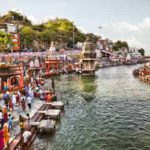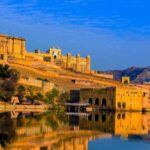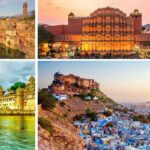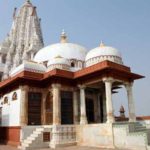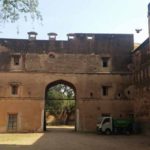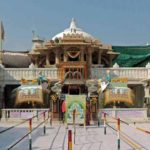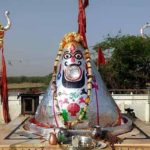Most Popular Winter Festivals in India is one of the world’s most beautiful countries and is renowned for its vibrant culture, customs, ancient architectural wonders, historical importance, beautiful destinations, and festival celebrations of various forms. Although several festivals are celebrated throughout the year in India, winter festivals in India are more enjoyable to be part of Indian festivals. So we’ve listed some of India’s best winter festivals today While visiting India during the winter season, every tourist should experience that.
Winter Season has a wide range of multicolor festivals, and holidays are celebrated in India, with most of India’s winter festivals taking place from December to February. Saraswati Puja or Vasant Panchami, Sunburn Goa festival, Christmas and Nagaur Festival are other important festivals of the winter season.
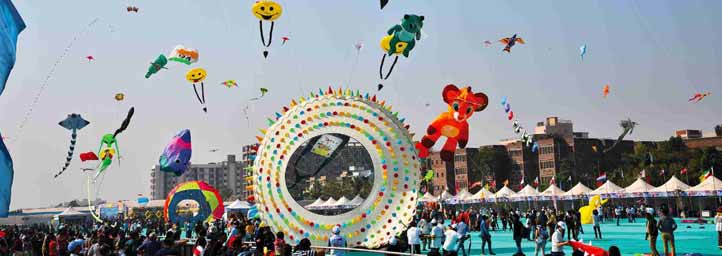
Gujarat Kite Festival
Uttarayan is a major festival celebrated by names such as Pongal, Makar Sankranti, Uttarayan, in the various regions and states of India to mark the end of long winter nights and cold breezes. In the state of Gujarat, the Uttarayan festival is celebrated extensively; the sky becomes a vibrant canvas drawn by the numerous kites flying high in the sky with the various hues of rainbow. Different kites can be seen lingering in the sky, playing hide and find with each other, hidden behind clouds, adding an animation to the skies that illuminates the atmosphere with the swift wind of summery happiness, marking a specific geographical shift in the form of the Gujarat Kite Festival.
Gujarat is witnessing the closing of all industries and people are rising to the rooftops from the monotonous ground life and collectively indulging themselves Flying kites, as if to lend their own mortal bodies wings. In essence, the Kite Festival, Gujarat, celebrates a change in the earth’s movement with the gusto and vigour that leaves in a happy frenzy rather indescribable in simple words, the minds and health of everyone across the state. Since before daylight hits the sky, before after dark, the heavens are adorned with countless kites. Kites of various sizes, shapes, patterns and colours are flown and a fun-filled competition is a tradition of cutting the strings of other nearby kites that invokes the child within each individual.
Both children and elders are excited to celebrate the Uttarayan festival in the unique style of Gujarati. The state awakens to a highly energised spirit that enlivens and brings exhilaration to all living things. With the enthusiasm of the festival and the Kite Festival, Gujarat is celebrated in a joyful and high-spirited atmosphere, the locals of the state are invigorated. Surat, Vadodara, Rjkot, Nadiad and most notably the city of Ahmedabad that annually conducts the International Kite Festival are the main places that see the festivities of the Kite Festival, Gujarat.
Gujarat’s Kite Festival has maintained its feelings of joy and delight for decades. While engaging in the friendly competition of kite flying, the happiness and exultation that Gujarat natives experience can not be negotiated for, and has a significant place in the list of celebrations that accompany the Uttarayan festival. This is the time to let the child loose inside and revel in the simple joys of life for people of all ages. The magnificent sky, smiling faces and homes illuminated with the radiance of togetherness and rejoicing are the characteristics that make Gujarat such a fun event for The Kite Festival.
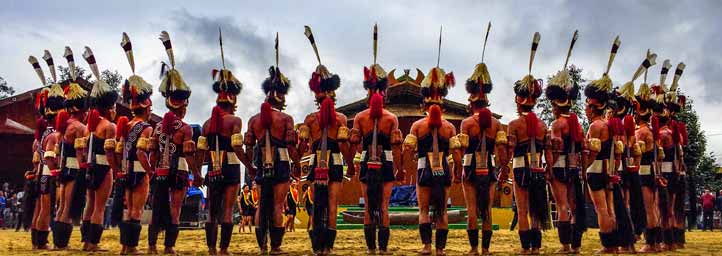
Hornbill Festival, Nagaland
This festival is very popular in Nagaland. The Hornbill Festival is a grand celebration that is brought to life every year in Nagaland, North East India, also referred to as the “festival of all festivals.” In its element and a powerful representation of the Naga community through splendid traditional music, dance and performances, the festival is gritting. The performances are perhaps highly eye-catching and need focus. In Nagaland, all diverse tribes give their heartfelt contribution to make the festival more lively and entertaining.
To make this celebration an exceptional opportunity, all individuals come together, united under one wing. This promising opportunity is visited by people from all over the world, either to merely witness or participate, or often both. The festival gives tourists a deeper insight into a greater understanding of Naga society. People are welcome to engage in various dance and musical events as well as contests that are lavish. This is a very beautiful demonstration of the cultural traditions of Nagaland. With their helping hands and smiles, the individuals of Nagaland are all the more generous. This charming festival has convinced visitors and travellers to visit the festival during their holidays.
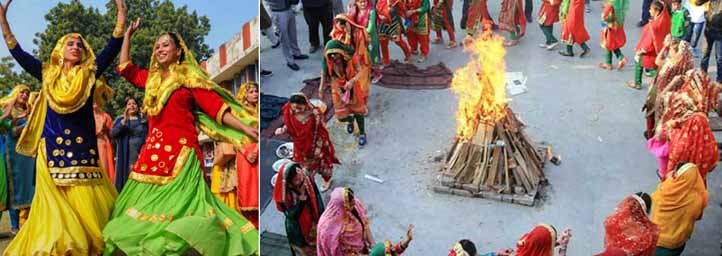
Lohri Festival Punjab
Every year, Lohri is celebrated on January 13th. It is a festival of fire worship. The Lohri Festival in North India, especially in Punjab, is celebrated with great pomp. Planet begins to tilt toward the sun at this moment, marking the auspicious phase of Uttarayan. For the newlywed and newborn babies, first Lohri is very crucial as it marks fertility. People gather around the bonfire at night and throw til, puffed rice & popcorns into the bonfire flames. The bonfire seeking wealth & prosperity is offered with prayers. By dancing & singing traditional folk songs, individuals make merry.
“In North India, Lohri coincides with various other festivals in various states, such as Bengal, the occasion is observed as “Makar Sankranti” in Assam as “Magha Bihu” and in Kerala as “Tai Pongal. It is the end of the winter season when the “Uttrarayan” sun shines, indicating less harsh winters, and more energy will be obtained from the planet.
Although there is no religious significance to the Lohri festival, it has a great social significance and is celebrated as a day to impart social love to one and all. The Lohri Festival is planned to relieve people from the everyday life of the world and make them relaxed, joyful, and happy. It is the moment when people come together from all castes and social strata, ignoring all previous disparities and grievances. Lohri succeeds in bridging the social divide every year as individuals visit families, distribute sweets, and salute each other.
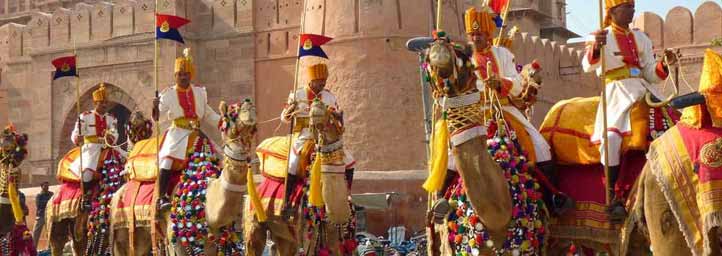
Bikaner Camel Festival
Bikaner is a vibrant desert town renowned for its outpost look of classic desert, grand ancient forts and others. You will enjoy a hustle-free holiday here, as it is rarely capsulated by tourism elements. The camel is a significant one among the many elements of Bikaner. In the desert regions of the country, camels were not just a form of transport. It was something of a living base, a sign of prestige, and even an embodiment of the desert region’s trade and finance. In exchange for money or other products, it is very popular among locals to trade camels and camel-based components with others.
Add to it a huge amount of entertainment and cultural activities; you get the famous Bikaner Camel Festival. Thousands of locals join the camel trade and share cultural events in Bikaner each year. Every second of this festival is devoted to the Desert Humped Boats. The government officially organises this festival to encourage tourism, which can effectively communicate the land’s heritage and culture. Will you want to see the desert region’s wholesome glory? It is time for the Bikaner Camel Festival to prepare your things.
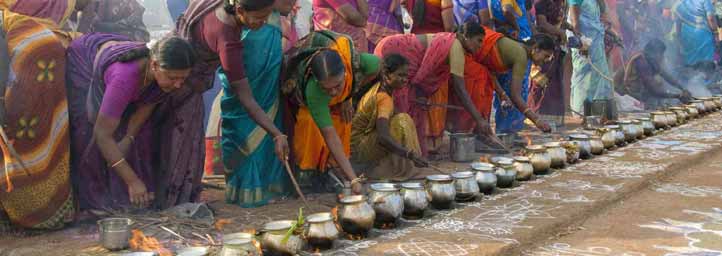
Pongal Festival, Tamil Nadu
The Pongal festival usually takes place every year during the second week of January. This is otherwise referred to as the Celebration of the Harvest or the ritual of gratitude. Farmers give their prayers to the Sun God in the latest season for the abundant harvest and also worship Him for a prosperous season ahead. In Tamil Nadu and the other states across the country, the Pongal festival is celebrated in a great way. In other nations, the Indian Diaspora also celebrates the Pongal Festival in a very significant way. January 14, as per the bill passed in the American Senate, was observed as Pongal Day.
Pongal is actually a festival lasting four days. The day of Pongal is actually referred to as Makara Sankaranthi, according to Hindu philosophy, when the Sun begins its journey to the equinox known as Utharayanam.
Actually, the Pongal celebrations begin one day before Makar Sankaranthi, and it is called Boghi. People are starting to clean their homes and clean up unnecessary things. The scientific truth behind Boghi is that we can lead a healthier life when we keep our living space clean and hygienic. Unused clothing, utensils and other stuff are taken away, and Boghi’s highlight is this.
Poojas and rituals for the Sun God are performed on the day of Makar Sankaranthi. Using the freshly harvested rice, sweets and savouries are made and are offered to God with prayers for the next good season. The Pongal festival is symbolised by sugar cane, and the word Pongal in Tamil is synonymous with abundance or overflow. Finally, this festival is celebrated primarily to thank the Sun God for a wonderful return and pray to Him in the near future for the prosperous season.
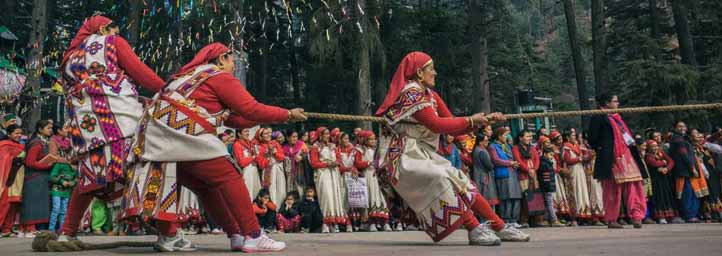
Manali Winter Carnival
A delightful festival that incorporates cultural as well as sports activities is the Manali Winter Carnival. Manu Kala Kendra hosts this 5-day festival celebrated in the month of Jan/Feb, which includes cultural carnival competitions.
Back in 1977, Himachal Pradesh started organising the Winter Carnival and now the festival has become bigger and better after almost three decades! The festival aims to highlight Himachal Pradesh’s special traditions. Many participants are invited to participate in the carnival from around India and it’s a major tourist attraction. The number of activities has increased, and among international visitors, the festival has also gained popularity.
The Winter Carnival began in Solang Nala as a skiing competition. At the same time as the skiing tournaments, it has now begun organising cultural activities. Many new attractions, such as the Skiing Championship, Now they have added Art Bazaar, Himachali Food Festival, Folk Dances, Street Plays, Local Band Competition, Adventure Sports, etc. Contests like ‘Queen of Winter’ and ‘Mr. Manali draws a lot of tourists, too.
The Manali Winter Carnival has the status of a state-level festival, declared a few years ago by the government of Himachal Pradesh. A large number of teams from different youth groups, colleges and universities across India take part in the carnival every year, their results being judged by a jury of judges. The Himachal Pradesh Chief Minister proclaimed the carnival to be a national festival during the 13th State Level Carnival.
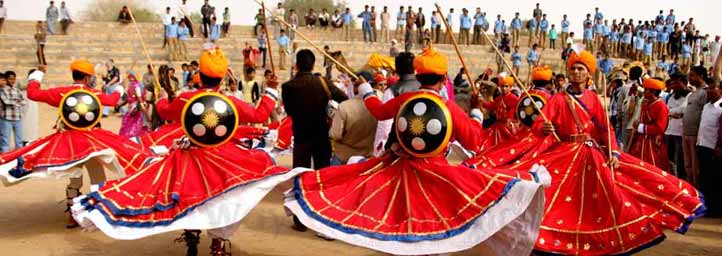
Jaisalmer Desert Festival
The Jaisalmer Desert Festival is an annual event that takes place in the beautiful city of Jaisalmer in February (Rajasthan). It is held three days prior to the full moon in the Hindu month of Magh. The festival is held in the magnificent dunes of the Thar Desert, in the dunes of Sam (42 kilometers from Jaisalmer). Romantic, remote and unspoiled, during the three day extravaganza of the delights of the desert, the place comes to life.
As legends claim, Lord Krishna, the ruler of the Yadav community, told Arjuna (one of the Pandavas) that his kingdom on Trikuta Hill will be founded by a successor belonging to the Yadav community.
In the year 1196, when Rawal Jaiswal, a descendant of the Yadav clan, founded his Kingdom in Jaisalmer, the prediction made by Lord Krishna came true. Throughout the kingdom, festivities were held as people came to know that the prophecy had come true. The festivities quickly grew into a festival that is now held annually. The government began promoting the colourful festival as a visitor to the Desert City for foreign drawings.
This festival’s festivities make the desert come alive with colour, passion and happiness. The festival begins with a procession from Jaisalmer Fort to Shahid Poonam Singh Stadium in the morning. The locals dress in costumes that are traditional and colourful. They sing and dance, portraying the desert’s tragedies and successes. Highlights of the festival are The Gair and the fire dance. A group of local nomads who are famous for their gymnastic acts are the Kalabaz or the Nat’s. With their poignant folk music recitals and ballads, the Bhopa Langhas and Manganiars create an enchanting atmosphere.
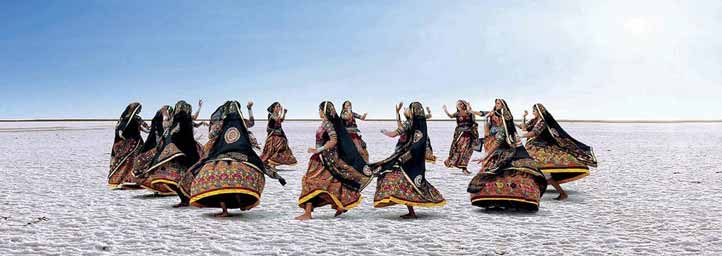
Kutch Rann Mahotsav
A Three Month Long Celebration at the edge of White Rann, also known as Kutch Festival or Just Rann Utsav, Rann of Kutch Festival. There are eight hubs in Gujarat Tourism and one of the best hubs is Kutch Tourism as part of Kutch Tourism, Gujarat Tourism Started to Celebrate Rann of Kutch Festival or Rann Utsav where tourists can stay with the option of Regular and Luxury Tents accommodation near white Rann of Kutch. Three months each year during the winter as part of Gujarat Tourism and Kutch Tourism Govt. Gujarat decided to set up a near-white Rann tent town. Thousands of people gather during the Kutch Festival to witness Rann of Kutch festival or Kutch Rann utsav to see Kutch attractions or Kutch sightseeing locations.
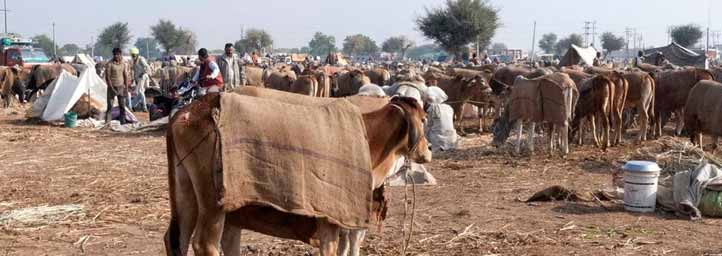
Nagaur Fair, Nagaur; Rajasthan
Throughout the Nagaur Fair of Rajasthan, the bellows of the cattle decorated by owners are festive and the full sound associated with fairs such as these. The Nagaur Fair is very well known in Rajasthan, and the exceptional guests of honour at this fair are—Cattle! Rajasthan’s Nagaur Fair has the exclusive distinction of becoming India’s second largest cattle fair.
The Rajasthan Nagaur Fair is one of the best eight-day cattle fairs in the world, held annually between late January and early February during the month of Magh. With the meeting of goats, horses, and camels escorted by their colourfully turbanized owners, Nagaur wakes up. Nagaur is a sea of animals that each year exhibits more than 70,000 bullocks, horses and around 25,000 camels. The beautiful metropolis of Nagaur, one of the most scenic townships in Rajput, In the course of the Nagaur Fair of Rajasthan, it stirs lifestyles. In between Bikaner and Jodhpur of Rajasthan, Nagaur, a village in Rajasthan, is located and is mainly extensive for the rustic appeal and colourful life visible by the way.
At Nagaur Fair, owners of animals from all over Rajasthan come and camp around the outskirts of Nagaur, buying and selling animals inside the fair.
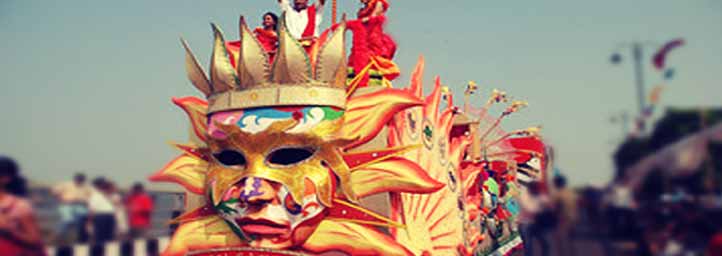
Carnival Festival, Goa
The Goa Carnival is the state’s most popular festival and has been observed as a precursor to Lent abstinence since the 18th century. The ‘Carnaval‘ is peculiar and unique to Goa, and was introduced for over five hundred years by the Portuguese who ruled over Goa.
With bands, floats and dances, massive colourful parades take over the state’s towns, while the evenings mean intense partying wherever you are.Try not to skip the festivities of the final day, ending with the popular red-and-black dance held in Panjim by the Clube Nacional.
In collaboration with the State Department of Tourism, float parades are organised. A special float hosting King Momo, a specially decorated float that will announce the decree of eat, drink and merry, will lead the float parade in Panaji.
While the three-day festival is mostly celebrated by Christians, it has also absorbed the revelry of Hindu culture, western styles of dance, and transformed into a sort of pageantry. While it began as a celebration only enjoyed by the local population, today it has crossed the boundaries of the state and attracts thousands of people from all over the country.
In February, the carnival takes place for three days and nights when the legendary king Momo takes over the state and the streets come alive With colour and music. Then the week-long event starts, which is a time of unbridled joy and merry-making, celebrated since the 18th century.
Just prior to the austere 40 days of Lent, the carnival is supposed to be a feasting-drinking-merrymaking orgy. With bands, dances and floats during the night on the streets, and grand balls held in the evenings, large parades are organised throughout the state. The crnival finishes on the final day with the popular red-and-black dance held at Panajim by the Clube National.
The origins and essence of the carnival can be traced to ancient Rome and Greece’s hedonistic feasts. In the Spanish and Portuguese colonies these carivals began, and eventually became popular for their music, dancing and drinking. The carnival is chaired by King Momo, who orders his subjects to party on the opening day. For carnival, hotel reservations must be done in advance as the festival draws thousands of visitors.

